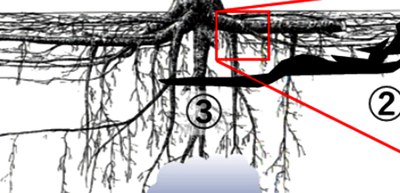
Typhoons with heavy precipitation increase a risk of forest disturbance
A group of researchers from Hokkaido University, the Research Institute for Humanity and Nature, the Disaster Prevention Research Institute, and Osaka University has found that heavy rain increases the risk of forest disturbance by typhoons, a kind of tropical storm.
Climate change is expected to increase precipitation brought by typhoons. Typhoons with heavy precipitation, in which rain causes more damage than wind, cause not only forest disturbances by wind but also forest disturbances by the interaction of storm and heavy rain.
The researchers assessed the disturbance risk to cool-temperate forests by typhoons that hit northern Japan in late August 2016, drawing the foregoing findings from machine learning modeling results. However, mechanisms behind forest disturbances due to strong wind and heavy rain were not well known. In order to reduce damage to the forest and infrastructure in the future, it is necessary to clarify features of typhoons with heavy precipitation and find effective solutions in forest management.
This group checked the status of forest disturbance in a total area of 325 km2 in the southern part of Hokkaido caused by three typhoons in late August 2016. They examined the areas of forest disturbance with trees partially uprooted or bole-snapped by the typhoons, performing mapping of forest disturbance using satellite images and calculating 17 forest disturbance-related parameters, such as climate, geography, and forestry.
Based on the typhoon’s speed and path obtained from computer simulations, they built a prediction model to estimate the forest disturbance probability gradient boosted decision trees (GBDTs), a machine learning method to model the forest disturbance risk.
As a result, they found that strong wind and a unique process mediated by storms and precipitation caused forest disturbance. Specifically, ridges that received strong wind from the front side had the highest risk of disturbance. In addition, precipitation increased the probability of forest disturbance and its effect depended on the dominant species composition.
The incidence of windthrow tends to be increased in trees that have poor root anchorage. As proper forest management to prevent forest disturbance by typhoons with heavy precipitation, this group recommends avoiding planting in ridges and planting tree species that horizontally growing side roots (laterals).
This group will need to verify their hypothesis regarding treefall mediated by storms and precipitation by experiments and modeling. It is already verified that plantation forests are more vulnerable to typhoons with strong winds than natural forests. This group’s achievements will be helpful in creating forest management measures.
Figure 1
Figure 2
Figure 3
Figure 4
Figure 5
The article, “Risk assessment of forest disturbance by typhoons with heavy precipitation in northern Japan,” was published in Forest Ecology and Management at DOI: https://doi.org/10.1016/j.foreco.2020.118521.
